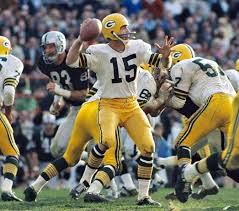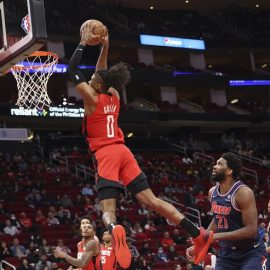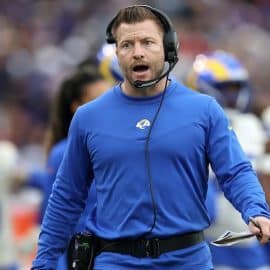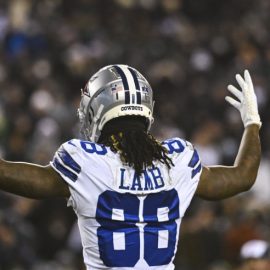Green Bay Packers great Bart Starr has died at the age of 85. The Pro Football Hall of Famer quarterbacked the club to five NFL titles in seven years including victories in the first two Super Bowls. Starr was also known as a class individual on and off the field who earned the respect of teammates and foes alike.
“A champion on and off the field, Bart epitomized class and was beloved by generations of Packers fans,” Packers president Mark Murphy said in a statement released by the team. “A clutch player who led his team to five NFL titles, Bart could still fill Lambeau Field with electricity decades later during his many visits.”
Bryan Bartlett Starr was born on January 9, 1934 in Montgomery, Alabama. He later attended the University of Alabama. After a successful junior season there, a back injury slowed Starr’s progress and he rarely saw the field as a senior. The Packers drafted him in the 17th round of the 1956 NFL Draft as a favor to the Alabama basketball coach who was a friend of the Packers player personnel director.
Starr struggled early in his Packers career, but flourished under Vince Lombardi, who took over as head coach in 1959. At first, Lombardi was not sure that Starr had what it took to be his starting quarterback, but by the end of the 1959 season, Starr had won the position and helped lead the Packers to their first winning record in more than a decade.
“When I joined this team, the opinion around here and in the league was that Starr would never make it. They said he couldn’t throw well enough and wasn’t tough enough, that he had no confidence in himself and that no one had confidence in him,” Vince Lombardi wrote in his 1962 book, “Run to Daylight,” co-authored with W.C. Heinz. “He was a top student at Alabama, so they said he was smart enough, and after looking at the movies that first preseason, I came to the conclusion that he did have the ability, the arm, the ball-handling techniques and the intelligence, and what he needed was confidence.”
Starr wasn’t brash or loud, but he had quiet confidence. He was also a hard worker and dedicated to being successful.
A turning point in his relationship with Lombardi came when the volatile coach yelled at Starr in front of the team after his quarterback made a mistake in practice. Starr spoke to Lombardi in his office and explained he could handle any criticism the coach had for him, but if Lombardi put down Starr in front of his teammates, he would undercut his ability to be perceived as a leader. The request created a mutual respect between the coach and his quarterback and Lombardi never chewed out Starr in front of his teammates again.
Starr became one of the greatest clutch players in NFL history. He led the Packers to 10 postseason games between 1960-1968 and won nine of them. To this date, Starr has the highest postseason rating of any quarterback in NFL history with a 104.8. He threw 15 touchdowns and just three interceptions in those 10 games and led the Packers to five NFL titles. Starr was also named the MVP of the first two Super Bowl games both of which Green Bay won handily.
His most famous moment came in the 1967 NFL Championship Game, better known as “The Ice Bowl.” The Packers were trying to become the first team in NFL history to win three consecutive championships and were facing a younger, more athletic Dallas Cowboys team. The game was played in inhuman conditions. The temperature at kickoff at Lambeau Field was minus-15 degrees Fahrenheit with a wind chill of approximately minus-45.
With 4:50 remaining in regulation time, the Packers took possession of the ball at their own 32-yard line, trailing 17-14. Starr used short passes and a combination of traps and draws to take advantage of the poor footing on the frozen turf and led the Packers down field. With 16 seconds left, the Packers faced a third-and-goal at the Dallas one-yard line in front of the south end zone. Starr called his final timeout and suggested to Lombardi that they run a wedge play but that he keep the ball instead of handing it to fullback Chuck Mercein who would have to take a few more steps on the icy field to move forward. Guard Jerry Kramer and center Ken Bowman combined to block out Dallas defensive tackle Jethro Pugh and Starr slipped into the end zone for the winning score.
The image of Starr crossing the goal line with Mercein behind him with his hands in the air remains one of the most iconic in the history of pro football. To this day, the 1965-67 Packers remain the only team in NFL history to win three consecutive championships in the playoff era.
Starr finished his NFL career in 1971. At the time of his retirement, he had the best career completion percentage in NFL history and the second highest career quarterback rating. Starr was selected to four Pro Bowls and was named the league’s MVP in 1966. He was inducted into the Pro Football Hall of Fame in 1977.
One year after his retirement, Starr served as quarterbacks coach of the Packers under head coach Dan Devine. He helped young Scott Hunter lead the Packers to a 10-4 record and the NFC Central Division title that year for their only non-strike playoff appearance between 1968-1992.
In 1975, Starr took over as head coach of the Pack. This was a tough assignment for Starr who admitted he lacked the experience to become an NFL head coach at the time. His teams struggled and his overall record at the helm of the Pack between 1975-1983 was a disappointing 52-76-2. His best season came in 1982 when he led the Packers to a 5-3-1 record in a strike-shortened season that included a win over the St. Louis Cardinals in the first round of the playoffs at Lambeau Field.
After leaving football, Starr became a very successful businessman. He and his wife Cherry were also involved in many charitable organizations including the Rawhide Boys Ranch in New London, Wisconsin, which provided help for at-risk boys throughout the state.
Starr suffered a series of health setbacks in 2014 including several strokes and a heart attack. He handled his rehabilitation with typical class and determination and was able to make a final appearance in Green Bay in 2017 to celebrate the 50th anniversary of the Ice Bowl.
“While he may always be best known for his success as the Packers quarterback for 16 years, his true legacy will always be the respectful manner in which he treated every person he met, his humble demeanor and his generous spirit,” the Starr family said in a statement released shortly after Bart’s passing. “His love for all of humanity is well known, and his affection toward the residents of Alabama and of Wisconsin filled him with gratitude. He had hoped to make one last trip to Green Bay to watch the Packers this fall, but he shall forever be there in spirit.”
Starr will be remembered as a classy athlete who overcame his limitations on the field with hard work and determination. He was a winner and a player who made those around him better. Each year, the NFL gives out the Bart Starr Award. It is given to the player who “best exemplifies outstanding character and leadership in the home, on the field, and in the community.” No more fitting tribute could be given to Bart Starr.
Add The Sports Daily to your Google News Feed!







